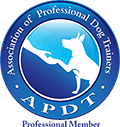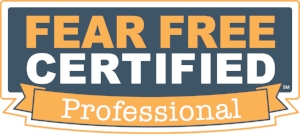Archive CF :: Calming an Anxious Dog
Because there are so many causes and so many contributors to stress in dogs, there are many varied ways of alleviating it. From changes as simple as an adjustment in diet to as complex as finding the most effective anti-anxiety medication, knowing the right course of action isn't easy, but here are some avenues to investigate.
Diet
There is much truth to the tenet: "You are what you eat". Dogs need to be on a high-quality diet for their best physical, behavioral, and emotional health. Many dogs thrive on a raw diet, but if you'd prefer using a dry food:
- Look for foods that have a meat source (e.g. "chicken") first in the ingredient list.
- Because a whole meat (e.g. "chicken") contains a lot of water, it's ideal if the second or third ingredient in the list is a specific meat meal (e.g. "turkey meal"). If the only other animal protein is much later in the list, it does not actually contain much animal protein.
- Avoid foods that contain by-products (either specific or general) early in the ingredient list.
- And avoid corn at all costs! Corn is a simple sugar, which no dog needs. Some dogs fairly vibrate when there's corn in their diet.
Exercise
Another much loved tenet is: "A tired dog is a good dog." No doubt you know from your own experience that physical exercise is a great stress reliever, so include exercise in your dog's daily routine. The morning is especially important for a dog who is going to be spending the day alone while you're at work. Even during the dog days of summer, there are indoor exercises you can do to stretch and strengthen your dog. Check with your vet about how much exercise is appropriate for your dog.
Mental Stimulation
One reason there is such a prevalence of behavior problems in pet dogs is that they have so little mental challenge; they need to have work to do! Providing them mental calisthenics through training and by using puzzle toys (such as the Kong toy) can be a great way to employ our dogs.
Play
Anxiety and playful feelings cannot exist in the same organism at the same time, so if you can elicit playful behavior from your dog in what might be an otherwise stressful situation, you can reframe that situation. For instance, some dogs are concerned about car rides, but if you can begin to associate their favorite game of fetch with tennis balls, first near the car, then perhaps through the back seats of the car, then in one open back seat and out again, etc, gradually increasing the stimulus of the experience of a car ride, you can decrease the anxiety associated with it. This is called desensitization and counter-conditioning.
Tricks that Calm
Training a dog to do a naturally occurring behavior on cue can be very helpful, particularly when that behavior is one that induces a happy, calm state. As a human example, don't you find it difficult to stay mad at someone after they make you laugh? Just the act of laughing affects your emotional and physical state. Blinking is another such a behavior.
At the start, reinforce for just a lazy eye, where the lids droop just a bit, not even a full blink. You'll find that your dog starts to soften her eyes and blink more often. You may even notice her starting to look sleepy!
When blinking becomes a frequent and intentional behavior, give the verbal cue "Blink!" and reinforce when your pup responds by blinking. Now, with good cue control, you have a way of influencing your dog's state of mind by affecting calm rather than anxiety.
Sensory Aids
The senses are a very powerful avenue for affecting calm in an anxious animal.
- Through a Dog’s Ear is a specially selected and arranged collection of music that has been demonstrated to calm dogs under stress. It can also be purchased with a companion book that explains how the aural environment can affect behavior.
- Massage can be an extremely helpful technique in calming an anxious dog. Long, slow, gentle strokes on various parts of the body, particularly the chest, can have very effective physical consequences such as slowing heart rate. It also might be worth investigating such therapeutic touch techniques as Tellington Touch, more commonly known as TTouch.
- Lavender helps reduce stress and anxiety in dogs. Spray about .16 ounces of diffused lavender oil on a towel or washcloth. Start associating the scent with pleasurable, relaxing activities, like soothing brushing or massaging. Then bring a lavender-scented towel along for situations that may cause stress, like a grooming or vet visit.
Supplementation
There are several alternative and holistic approaches that can relieve a stressed dog:
- Bach Flower Remedies, and particularly Rescue Remedy, can help a dog to relax and be more at ease.
- Adaptil, formerly DAP, is a synthetically produced pheromone that mimics the "appeasing" pheromones secreted by nursing mother dogs, communicating comfort to her pups. Plug a DAP diffuser near the crate or wherever your dog spends the most time.
- Tryptophan is an amino acid precursor to serotonin, the "happy" neurotransmitter that elevates mood. To increase tryptophan in the diet, feed a mixture of brown rice and cooked carrots to your dog two hours after a meal. Alternatively, you can use a tryptophan supplement such as ProQuiet.
- L-Theanine chewable tablets have been shown to have a relaxing effect on dogs who suffer from phobias such as noise-triggered phobias and can increase their abilities to learn, hence facilitating behavior modification.
- Omega 3 fatty acids have been shown to elevate mood and decrease anxiety in humans. Omega 3s are also great for the health of coat and skin. When introducing this to the diet, start at half the suggested daily dosage and work up gradually (sudden introduction can cause diarrhea).
- The Calming Care ProBiotic supplement has been shown to help pets with anxiety and fear, in particular noise phobias, separation issues, and anxiety during vet visits.
- CBD oil is the new fad for humans and for dogs. There's anecdotal evidence suggesting that it aids in treating pain, has anti-inflammatory properties, cardiac benefits, anti-nausea effects and appetite stimulation, anti-anxiety impact, possibly even anti-cancer benefits. It seems there's little it doesn't help with! Start at the lowest dose and increase from there and, of course, consult your vet.
Equipment
- Swaddling a dog has been found to help lower stress and fear in dogs. Such equipment is called an anxiety wrap. There are several commercial products available: the ThunderShirt can help calm your dog during scary events like thunderstorms, fireworks, separation anxiety, etc. Other such products are the Anxiety Wrap and the Storm Defender. Or you can try just putting a snug doggie Tee on your dog to see if it helps.
- A calming cap works a bit like blinkers on a horse. It can be helpful in decreasing the visual stimuli that are associated with certain high-stress situations, such as nail clipping.
Medication
Medication will hopefully not be necessary forever but the advantage of it is that it can take a bit of the edge off of the anxiety, enough to allow your dog to learn faster from the training and behavior modification techniques you're doing. If a dog is too fearful or anxious, for instance, it's hard to let the good experiences in completely, and medication can help with this. The most widely used are TCAs (tricyclic antidepressants) and SSRIs (selective serotonin-reuptake inhibitors), which are long-term slow-acting anti-anxiety medications. Benzodiazepines are fast-acting anti-anxieties best used for situational distress such as thunderstorm phobias. Your vet can help you decide what seems the best course of treatment.
Final Thoughts
It might go without saying but it doesn't hurt to be explicit: If there's something in your dog's environment that is causing stress, do what you can to eliminate it if possible. For instance, if, while you're at work, street noise is making him anxious, then have him spend his time in a room that is quieter and away from noisy windows. If your younger dog is "dogging" your older one, make sure he has plenty of time to himself to relax unbothered and also set aside time to devote some of your own personal attention to him away from the young whippersnapper.
Also remember that the use of punishment only tends to increase anxiety in an anxious dog. Using positive techniques when training and doing behavior modification will help build confidence in a dog who lacks it.




